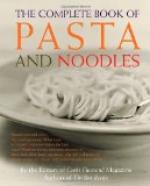FOOTNOTES:
[1] Abridged from the story of “Silly Matt” in Sir George W. Dasent’s Tales from the Fjeld.
[2] Professor Crane’s Italian Popular Tales, p. 302. This actual throwing of eyes occurs in the folk-tales of Europe generally.
[3] In Le Cabinet des Fees, 1788 (tome xxxviii., p. 337 ff.).— There can be no such name as Xailoun in Arabic; that of the noodle’s wife, Oitba, may be intended for “Utba.” Cazotte has so Frenchified the names of the characters in his tales as to render their identification with the Arabic originals (where he had any such) often impossible. Although this story is not found in any known Arabian text of the Book of the Thousand and One Nights, yet the incidents for the most part occur in several Eastern story-books.
[4] On a similar occasion Giufa, the Sicilian brother to the Arabian fool, did somewhat more mischief. Once his mother went to church and told him to make some porridge for his baby-sister. Giufa made a great pot of porridge and fed the baby with it, and burned her mouth so that she died. Another time his mother on leaving home told him to feed the hen that was sitting and put her back in the nest, so that the eggs should not get cold. Giufa stuffed the hen with food so that he killed her, and then sat on the eggs himself until his mother returned.—See Crane’s Italian Popular Tales, pp. 296-7.
[5] Abridged and modified from a version in the Folk-Lore Record, vol. iii., pp. 153-5.
[6] The usual mode by which in the East thieves break into houses, which are for the most part constructed of clay. See Job xxiv. 16.
[7] Kurakkan is a species of grain.
[8] The Orientalist, June, 1884, pp. 137-8.
[9] Ummu Sulayman. In Arabia the mother is generally addressed in this way as a mark of respect for having borne children, and the eldest gives the title. Our bang-eater supposed he was addressing an old woman who had (or might have had) a son named Solomon.
[10] See Ralston’s Russian Folk-Tales. [Transcriber’s note: Footnote reference missing from original, p. 153]
[11] From a paper on “Comparative Folk-lore,” by W. Goonetilleke, in The Orientalist, i., p. 122.
[12] Mery Tales, Wittie Questions, and Quicke Answeres, very pleasant to be Readde. Imprinted at London by H. Wykes, 1567.




